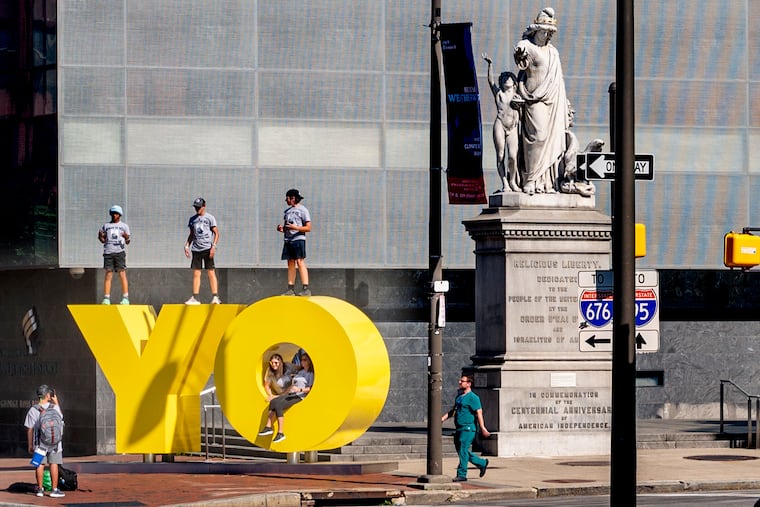Philly prides itself on welcoming immigrants. Now it wants to make it official.
'Rest assured that we stand with our immigrant communities,' said Mayor Jim Kenney

Philadelphia has long prided itself on being a welcoming city for immigrants — and now wants to make it official.
The city is seeking to be designated as a “certified welcoming” community, a status achieved by only 15 locales in the United States, including Baltimore, Charlotte, Dallas, Detroit, Pittsburgh, and San Jose.
It’s a formal designation for cities and counties that have created policies and programs that commit to including immigrants in civic, social, and economic life. It aims to give those cities an edge in attracting newcomers and gaining global opportunities to bring in new businesses.
Cities seeking “certified status” must meet standards for inclusion in government, education, economic development, and safety, as set by the nonprofit Welcoming America. That organization promotes the creation of communities that are not merely friendly and tolerant but that embrace practices that include immigrants.
“It gives us a road map,” said Amy Eusebio, executive director of the city Office of Immigrant Affairs. “What’s the next phase of things we should be tackling as a city if we truly want to be a welcoming city?”
Other places have used the designation as a means to help draw in new businesses — a kind of seal of approval for companies that demand a welcoming environment.
For instance, officials in Erie say they sought the designation because it would help them “unleash the power of New Americans, create a stronger community, and gain economic advantage.”
The months-long certification process includes a two-day, in-person audit by staff from Welcoming America. The city of Philadelphia could be approved by the end of the year.
The city made the announcement on Wednesday, at the start of Immigrant Heritage Month, which highlights the importance of immigration and recognizes the contributions of immigrants locally and nationally. Multiple events are planned in the Philadelphia region in June.
In recent months, Philadelphia has played a major role in welcoming Afghans who were evacuated from war-riven Afghanistan and Ukrainians who are fleeing the Russian invasion of their homeland. It’s also seen new Haitian arrivals, many of whom have sought shelter and safety here after the 2021 earthquake that devastated the southwest part of the country.
The region is home to one of the nation’s largest Ukrainian communities, and they and other supporters have mounted a huge effort to help new arrivals. About 15,245 Ukrainian immigrants live in Philadelphia and the surrounding suburban and South Jersey counties, along with 54,324 people of Ukrainian ancestry.
The chaotic August withdrawal that ended the United States’ 20-year war in Afghanistan prompted a massive airlift and made Philadelphia International Airport the nation’s main arrival hub. The airport welcomed more than 30,000 evacuees, and Joint Base McGuire-Dix-Lakehurst in South Jersey erected what was essentially a small city to process newcomers.
At least 4,000 Afghans are expected to permanently settle here, doubling the existing population.
Mayor Jim Kenney said in a statement Wednesday that the challenges of the COVID-19 pandemic have been “economically and mentally difficult for all of Philadelphia’s residents, including our immigrants,” and that the violence some immigrant communities have endured is “despicable.”
“As a Welcoming City, we must always say no to hate and violence,” the mayor said. “Rest assured that we stand with our immigrant communities.”
In Philadelphia, the arrival of immigrants has helped fuel new businesses and jobs, and brought fresh ideas and new vitality, advocates point out.
Immigrants make up 14.3% of the city, or about 225,400 people among a population of 1,576,251, according to the most recent Census figures. That percentage is twice that of Pennsylvania as a whole.
The percentage of city residents who were born outside the United States doubled between 1990 and 2017. China was far and away the main sending country, according to a Pew Charitable Trusts analysis, followed by the Dominican Republic, Jamaica, India, and Vietnam.
More than a quarter of city residents are immigrants or have a foreign-born parent, Pew reported, and 23% speak a language other than English at home.
The city also announced on Wednesday that it had received a $75,000 grant from the Open Society Foundation to better integrate Afghan newcomers. The money will help the city hire a consultant to help establish a Philadelphia Welcoming Network that would support Afghans, Haitians, Ukrainians, and other emerging immigrant communities.